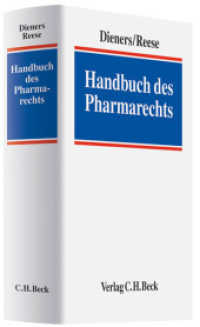- ホーム
- > 洋書
- > 英文書
- > Science / Mathematics
Full Description
This title was first published in 2001. A comprehensive collection of the leading articles important in the development of the use of emissions trading to control air pollution from its earliest implementation in the USA in 1976, to its application to global warming in the Kyoto Protocol.
Contents
Contentsanalysis of alternative air quality control strategies, Scott E. Atkinson and Donald H. Lewis; The empirical properties of 2 classes of designs for transferable discharge permit markets, Scott E. Atkinson and T.H. Tietenberg; Am empirical analysis of economic strategies for controlling air pollution, Eugene P. Seskin, Robert J. Anderson Jr and Robert O. Reid; Cost-effective policies to improve urban air quality in Santiago, Chile, RA!ul E. O'Ryan. Implementation and Evaluation: Implementation Issues: The net benefits of incentive-based regulation: a case of environmental standard setting, Wallace E. Oates, Paul R. Portney and Albert M. McGartland; Transaction costs and tradable permits, Robert N. Stavins; Environmental benefits from marketable discharge permits or an ecological vs economical perspective on marketable permits, Catherine L. Kling; US interest groups prefer emission trading: a new perspective, Gert Tinggaard. The Early Programs (1975-1990): Emissions trading: why is this thoroughbred hobbled?, Daniel J. Dudek and John Palmisano; Marketable permits: lessons for theory and practice, Robert W. Hahn and Gordon L. Hester. The Later Programs (1990-): The Sulfur Allowance Program: The market for sulfur dioxide emissions, Paul L. Joskow, Richard Schmalensee and Elizabeth M. Bailey; What can we learn from the grand policy experiment? Lessons from SO2 allowance trading, Robert N. Stavins; The environmental effects of SO2 trading and banking, Dallas Burtraw and Erin Mansur. The NOxBudget Program: The NOx budget: market-based control of tropospheric ozone in the North-Eastern United States, Alex Farrell, Roger Raufer and Kimberly Killmer. State Level Programs: Designing more efficient markets: lessons from Los Angeles smog control, Vivien Foster and Robert W. Hahn; Emission trading in theory and practice: an analysis of RECLAIM in Southern California, O. Fromm and B. Hansjurgens; State-level air emissions trading: the Michigan and Illinois models, Barry D. Solomon and Hugh S. Gorman. Climate Change: Global environment regulation: instrument choice in legal context, Jonathan Baert Wiener; Index. Volume II: Introduction: Early History: The problem of social cost, R.H. Coase; The structuring of atmospheric pollution control systems, Thomas D. Crocker; Land, water and ownership, J.H. Dales. The Theoretical Foundations: The use of standards and prices for protection of the environment, William J. Baumol and Wallace E. Oates; Markets in licences and efficient pollution control programs, W. David Montgomery; The symmetry between controlling pollution by price and controlling it by quantity, John Pezzey. Design Issues: Initial Allocations: Equilibrium properties of auctions and alternative procedures for allocation transferable permits, Randolph M. Lyon; Approaches for reaching ambient standards in non-attainment areas: financial burden and efficiency considerations, Scott E. Atkinson and Tom H. Tietenberg; When can carbon abatement policies increase welfare? The fundamental role of distorted factor markets, Ian W.H. Parry, Roberton C. Williams III and Lawrence H. Goulder; Emissions trading with shares and coupons when control over discharges is uncertain, Robert W.Godby, Stuart Mestelman, R. Andrew Muller and J. Douglas Welland. Market Power: Market power and transferable property rights, Robert W. Hahn; Exclusionary manipulation of markets for pollution rights, Walter S. Misiolek and Harold W. Elder; Tradable emission permits regulations in the presence of imperfectly competitive product markets: welfare implications, Eftichios Sophocles Sartzetakis; Tradable emission rights and strategic interaction, Nils-Hendrik Morch von der Fehr. Spatial Issues: Economic implications of emission trading rules for local and regional pollutants, Scott E. Atkinson and Tom H. Tietenberg; On marketable air pollution permits: the case for a system of pollution offsets, Alan J. Krupnick, Wallace E. Oates and Eric van den Verg; Marketable permits for the prevention of environmental deterioration, Albert M. McGartland and Wallace E. Oates; Market failure in incentive-based regulation: the case of emissions trading, Scott E. Atkinson and Tom Tietenberg; Improving efficiency in bilateral emission trading, Dallas Burtraw, Kenneth W. Harrison and Paul Turner. Temporal Issues: A model of intertemporal emission trading, banking and borrowing, Jonathan D. Rubin; Regulated firms in pollution permit markets with banking, Mark B. Kronshaw and Jamie Brown Kruse; How should an accumulative toxic substance be banned?, Michael Toman and Karen Palmer; Priority pollution rights: adapting pollution control to a variable environment, Charles W. Howe and Dwight R. Lee. Ethical Issues: Selling environmental indulgences, Robert E. Goodin; Ethical influences on the evolution of the US tradable permit approach to air pollution control, Tom Tietenberg; Index.







